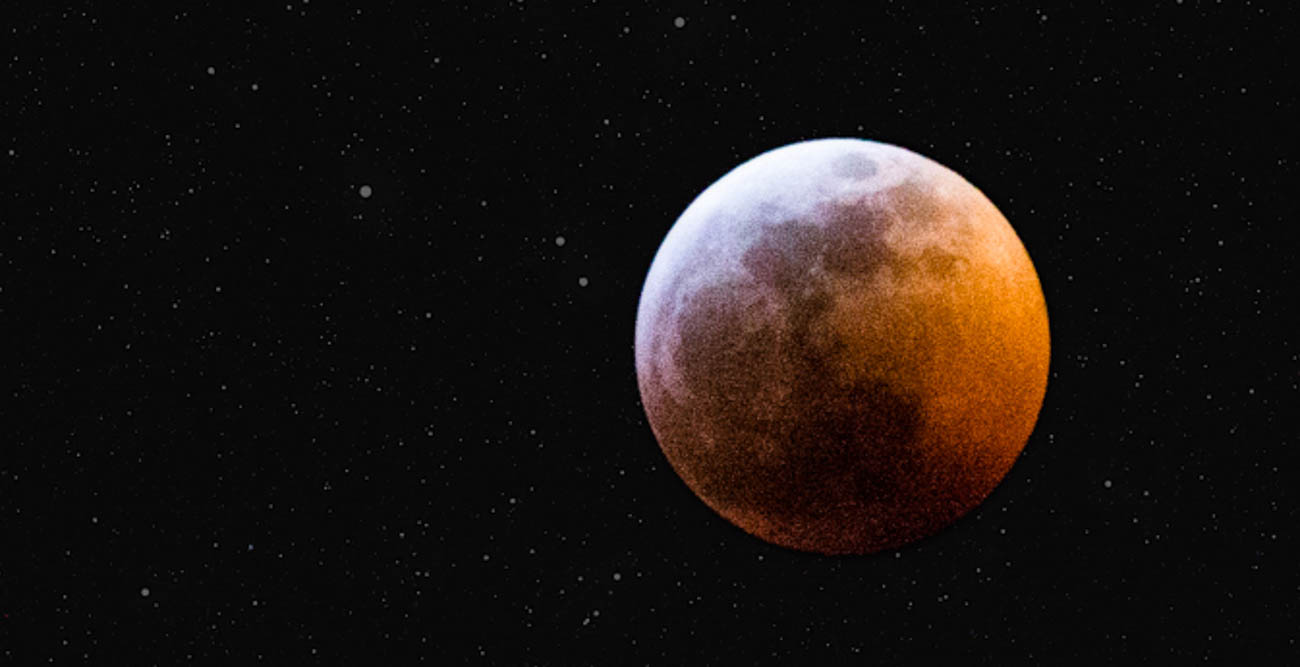Top 7 Astronomical Phenomena This Year
Posted on February 22, 2019

On the evening of Sunday, Jan. 20, blessed with unusually clear skies, the Mobile area had front-row seats to the spectacle of a lunar eclipse. For more than an hour, the moon was swallowed up by Earth’s surly shadow, illumined only by sunset-red refracted light – a “blood moon.” Overnight, social media was flooded with pictures by amateur photographers and astronomers nationwide.
Of all the sciences, astronomy seems to capture the public imagination the most, probably because everyone can participate in it. Not everyone can set up a chemistry lab, but nearly everyone can look up, noted Dr. Albert Gapud, associate professor of physics. It is not surprising that amateurs play a bigger role in astronomy than in any other science, particularly in making new discoveries. In fact, it was amateurs who first noticed a small meteor impact on the moon during the lunar eclipse. There are countless amateur groups worldwide, including our own Mobile Astronomical Society.
The University of South Alabama Department of Physics shares this same passion, for it is in astronomical phenomena that fundamental physics is put on grand display, from the gravitational dance of Saturn’s rings to time-bending black holes. The department often hosts stargazing activities for community groups in the area, and offer astronomy classes at the introductory and junior levels. Notably, instructor Rod Mollise may be the area’s foremost expert in the design and construction of telescopes, having published articles and books on the subject, and just about anyone in the faculty can set up the department’s telescopes for an impromptu session.
Gapud offers this list of astronomical events to watch for the rest of this year, which everyone in Mobile can witness without any special equipment (weather permitting, of course):
- Starting Feb. 27, a chance (or six!) to see Mercury. This planet can be viewed with the naked eye; however, since it is the closest planet to the sun, it rarely strays far enough from the sun’s glare, which is why the only way to see it is either just after sunset or just before sunrise. As this places Mercury low in the sky, you have the added obscuration of Gulf Coast haze often present along the horizon. The best chance, then, is whenever Mercury is at its farthest swing from the sun, or “maximum elongation,” about 28 degrees. The good news is that this will happen SIX times this year. You can try to catch Mercury just after sunset on Feb. 27, June 23 or Oct. 20, or just before sunrise on April 11, Aug. 9 or Nov. 28. How to know you’re looking at a planet and not at a star? Planets don’t twinkle. Even the brightest star, Sirius, noticeably twinkles. That’s because stars are so far away that they appear as minute points of light, easily diffracted by eddies and dust in our atmosphere. Naked-eye planets, by contrast, appear larger, as small but distinct discs.
- “Super Moon,” March 21, evening. This refers to an unusually bright full moon, appearing 7 percent larger than average because the moon also happens to be at its closest approach to Earth in its elliptical orbit. The Jan. 20 lunar eclipse was a Super “Blood” Moon. The Super Moon just this past Feb. 19 was the brightest of the year. The best time to witness the March Super Moon is just after sunset, when it starts to rise in the East. This is also when the moon’s size is in stark contrast to buildings and trees along the horizon – an effect that’s enhanced when it’s “Super.” Also noteworthy is that this occurs almost simultaneously with spring equinox, when the day is halfway as long between the longest and shortest day of the year.
- Venus, the morning “star.” Go outside on any clear morning between now and August, about an hour or so before sunrise, look southeast, and you will easily notice Venus, the third brightest object in our sky. It is an inner planet like Mercury and therefore visible only just after sunset as an “evening star” or just before sunrise as a “morning star.” However, Venus is farther out, and so has a considerably longer elongation from the sun’s glare and is visible for up to two hours longer. After August, it will be an evening star.
- Speaking of planets, other naked-eye planets are visible throughout the year. Mars, visible as a bright red light, is in the sky now after sunset, until late July, after which it won’t be visible again until just before sunrise starting mid-September. Jupiter is almost as bright as Venus, and visible now until the end of the year, a few hours before sunrise until mid-August; thereafter, it’s visible a few hours after sunset. Saturn has a similar schedule, except about a month behind Jupiter. Tip: There are free cell phone apps that can help you locate these planets (along with constellations and many other objects) by holding your phone up to the sky.
- Conjunction of Venus and Jupiter, Nov. 24, evening. Just after sunset, low in the southwest, two of the brightest lights in sky (second only to the sun and the full moon) will be twin lights almost on top of each other – a rare “conjunction.” Also, Saturn won’t be too far from this pair.
- Meteor showers. This phenomenon occurs when the Earth plows through a debris field left behind usually by a disintegrated comet. The debris burn up in our atmosphere as meteors, or “shooting stars.” Since we face “head on” along our orbit’s direction after midnight, this is the best time to view. Tip: Organize a “meteor counting” contest far away from city lights and where you have a wide view of the sky. Spread out some blankets, douse all lights and flashlights to help keep your pupils dilated and more sensitive to these brief streaks of light, lie down and look up. The one who counts the most meteors wins! Plus, every now and then, you might even see a bright “fireball” that lasts up to two seconds! The first two showers of the year, Eta Aquarids on May 6-7 and the Perseids on Aug. 12-13, are each forecast to yield about 60 per hour at their peak. That’s an average of one per minute. If you miss both of these, you have one more chance.
- The mother of all meteor showers: Geminids, Dec. 13-14. A fitting finale for the calendar year. If you’re going to see just one meteor shower this year, this is it. It won’t be as warm outside, but it would be well worth it, at a forecast maximum of 120 meteors per hour! This would be the best time for that meteor counting contest, perhaps bundled up in sleeping bags on foldout cots while sipping hot peppermint cocoa.
There are other events this year that will require a telescope and safe conditions; for example, a rare transit of Mercury across the face of the sun in November! For these events, the USA Department of Physics just might bring out the telescopes for public viewing, so stay tuned for announcements! Meanwhile, you never know when Mother Nature is putting on a show in the sky so – every now and then – remember to look up.
Dr. Albert Gapud (“Dr. G”), associate professor of physics, has been with the USA Department of Physics for 13 years, lecturing in introductory and conceptual physics and astronomy. His research is in the condensed-matter physics of superconductors. When he is not looking up, he may be pouring liquefied gas or powering up the strongest magnet on campus.





